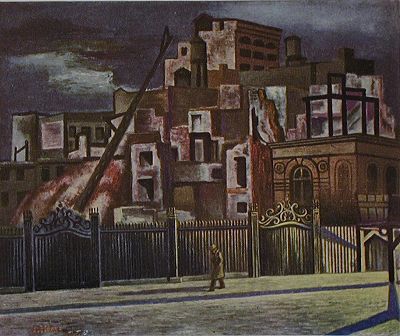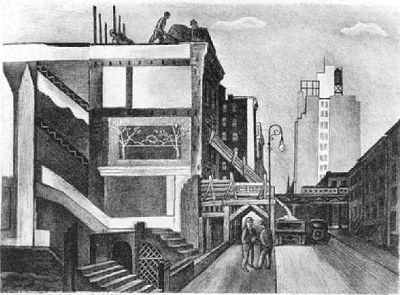|
Table of Contents
|
|
To navigate
The Fiene Quintanilla Online Catalogue Raisonné Project, use the links below. |
| Useful Links |
| Fiene Copyright ©2006, Jeffrey Coven, CATRAIS Copyright ©2010 IA\TPC |
A Catalogue Raisonné -- in progress
Catalogue Entry # 66
(Click here for explanation of catalogue entry #s and titles.)
Date: 1932
Medium: Lithograph
Edition: 7*
Dimensions: 10 3/16 x 14 3/16 in.
Printer: George C. Miller
Typical pencil annotations on impressions from the edition: numbered and titled (l.l.); signed and dated (l.r.).
Public collections holding this print: Currently Unknown (CU)
Topic galleries for this print:
1. New York City Scenes
2. Worker Scenes
*Edition: This is Fiene's smallest numbered edition. Even editions of states that were numbered were usually larger than seven. (See Brooklyn Bridge.)
Related Works: The painting Fall of Old Houses (purchased by Duncan Phillips from a Museum of Modern Art exhibition in 1931, and now at The Phillips Collection in Washington, D.C.) corresponds in composition very closely to the lithograph Razing Buildings, West 49th Street. Originally, the painting and lithograph had the same title -- the title the lithograph still bears. Of the painting, Fiene writes, My painting, Fall of Old Houses . . . was painted in the summer of 1931 [sic, most likely he meant 1930] at the time when several blocks of buildings were razed to make way for Rockefeller Center. The study of buildings in the process of wrecking fascinates me. I find not only the anatomy of the building laid bare but can also visualize the people who lived there. In this painting, the buildings in the foreground are down showing the inner wall clinging to the next building [while] the stairway [leads] to a more secluded room graced by a wall painting of a sunset over a lake . . . . To me this is so expressive of an earlier period reminiscent of the horse and buggy, the bicycle and a far more leisurely tempo." This image for the artist is a "record of the ever changing scene which is constantly taking place in New York . . . the sharp contrast between these charming old buildings and the skyscraper . . . so expressive of our day" (Unpublished typescript, (Fiene "Ernest Fiene Papers," reel 2353).
When Henri Matisse visited the Museum of Modern Art in 1930, the famous French artist toured an exhibition of American painting at the press preview. His informal guide turned out to be Henry McBride, editor of Creative Art Magazine. McBride noted that Matisse, whom he referred to in a column written shortly thereafter, only as "a distinguished French painter" was apparently his usual quiet self, not saying much about any of the paintings, with the exception of one. It was "Razing Buildings, [West] 49th Street" by Fiene, which Matisse found, according to McBride, "especially agreeable." McBride writes:
- What he actually said was, . . . "Ca ne manque presque rien" ("It lacks almost nothing") -- and with that he touched the canvas caressingly, and as only a painter can, at the spot where the roofs of the houses met the sky, and added "That's fine. it only needs --" and he blew a little whiff of air with his lips as though to indicate that just a hair's breadth more and the picture would have been great." (McBride sup.-10).
Fiene created a series of paintings during the early Thirties on the subject of old buildings in New York City being razed to make way for the new. For an example, see below.
 |
Changing Old New York, c. 1932, oil on canvas.
(Photo courtesy of the estate of Ernest Fiene) |
